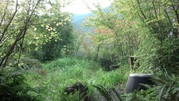Sometimes, when I get a quiet moment to myself and I am feeling a certain intangibly inexpressible way, pansori comes into my mind.
If you don't know what pansori is, it is what I would consider to be Korean traditional musical storytelling usually performed by one singer or more, most often supported by one or more Korean traditional percussion instruments.
The term pansori is derived from:
pan meaning 'a place where many people gather' and
sori meaning 'sound.'
It is thought to have originated from muga or shamanistic songs.
See <https://en.wikipedia.org/wiki/Pansori>
for more about pansori.
Now, pansori is something that when I really let myself get into it, it gives me these deep-heart smiles because of the strength, grace, and sheer fearlessness in expression demonstrated by the singers and supporting musicians.
Digging through my things yesterday, I found this album of Korean folk music called 남도민요 2 (Namdominyo 2) – that is from the region I am from in Korea 전라남도 (South Jeolla Province). In revisiting it recently, I am realizing in deep ancestral ways why I might be drawn to the types of rhythms and vocal qualities that I am drawn to.
This song-- 새타령(Sae-taryung) is a song I remember so vividly from my childhood. Here is the Namdominyo version – plus a couple others.
If you don't know what pansori is, it is what I would consider to be Korean traditional musical storytelling usually performed by one singer or more, most often supported by one or more Korean traditional percussion instruments.
The term pansori is derived from:
pan meaning 'a place where many people gather' and
sori meaning 'sound.'
It is thought to have originated from muga or shamanistic songs.
See <https://en.wikipedia.org/wiki/Pansori>
for more about pansori.
Now, pansori is something that when I really let myself get into it, it gives me these deep-heart smiles because of the strength, grace, and sheer fearlessness in expression demonstrated by the singers and supporting musicians.
Digging through my things yesterday, I found this album of Korean folk music called 남도민요 2 (Namdominyo 2) – that is from the region I am from in Korea 전라남도 (South Jeolla Province). In revisiting it recently, I am realizing in deep ancestral ways why I might be drawn to the types of rhythms and vocal qualities that I am drawn to.
This song-- 새타령(Sae-taryung) is a song I remember so vividly from my childhood. Here is the Namdominyo version – plus a couple others.
As a child, my parents were part of the Korean church community where people would take turns hosting what were essentially karaoke parties that ran deep deep into the night.
The one song that always stuck out to me was this one. It was a song that a lady I remember only as “Jason's Mom” would choose to sing and I always giggled, but I also secretly thought this was one of the coolest things I had ever heard. The minor key, the natural lilting flow of the rhythm, and the striking bird calls were magical to me.
Here's the karaoke version of Sae-taryung:
The one song that always stuck out to me was this one. It was a song that a lady I remember only as “Jason's Mom” would choose to sing and I always giggled, but I also secretly thought this was one of the coolest things I had ever heard. The minor key, the natural lilting flow of the rhythm, and the striking bird calls were magical to me.
Here's the karaoke version of Sae-taryung:
Now in writing this post and realizing how often I come back to this, I am feeling the need to compile a pansori resource to share openly for those interested in this type of exploration.
Here it is for your perusing pleasure:
https://padlet.com/yim_yeonhee/10xsi6tbcrch
Thanks for reading, and I hope you enjoy this taste of Korean traditional music!
Here it is for your perusing pleasure:
https://padlet.com/yim_yeonhee/10xsi6tbcrch
Thanks for reading, and I hope you enjoy this taste of Korean traditional music!

Yeon-Hee Yim
Nature Lover, Explorer, Audio Director,
Lead Composer, Master Music Guide
@Sonaesthetics Studios
Like what you've experienced and want more?





 RSS Feed
RSS Feed
